Introduction
Bosch's patent, and the resulting machines, have been around for about two years now, and they're designed specifically to lower your energy consumption and to save you money...that is, in the long run. Zeolite technology adds to the cost of the overall machine, meaning you'll have to shell out about €1200 ($1512) to start. We were told that these particular models are expected to last roughly 10 to 15 years, though, which allows for a long time to let those energy cuts take effect. Add to that the fact that these products also recycle some of the water used from one load to another, it's very easy to get excited about the long-term savings that a dishwasher with these combined pieces of technology could potentially yield.
Front
{{section_header}}{{section.name}}{{/section_header}}
This particular model, the SMU69U65EU, is more or less a regular partially integrated dishwasher with a stainless finish. Nothing terribly unusual on the outside, though we were led to believe that the finished product won't have a see-through door.
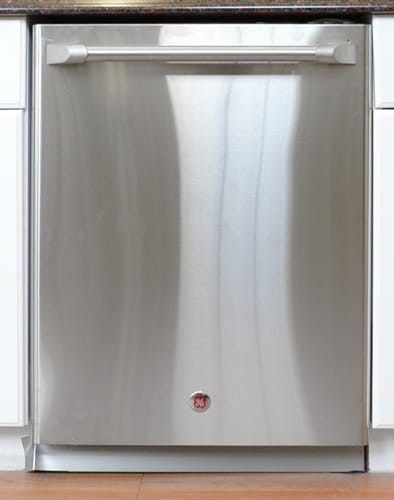
The front of the GE CDWT980VSS.
Finish
{{section_header}}{{section.name}}{{/section_header}}

Controls
{{section_header}}{{section.name}}{{/section_header}}
It's a partially integrated machine, so you'll be able to keep track of what's going on using the nifty little screen on the front. Since the text is a white-ish color, it didn't appear at all obtrusive or distracting.
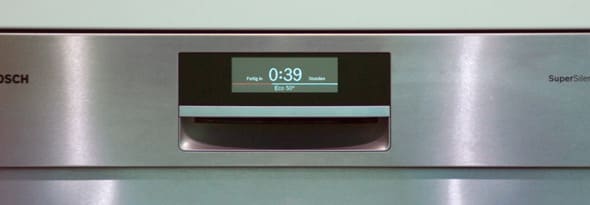
The rest of the controls—are there sure are a lot of them—are found on the top of the door frame, which is par for the course as far as this particular design is concerned.
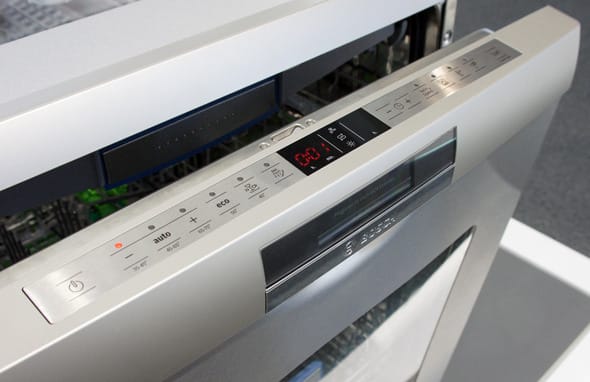

Interior
{{section_header}}{{section.name}}{{/section_header}}
The red glowing bit is meant to indicate the location of the zeolite inside the dishwasher. We can't say for sure just how far underneath it extends, but the point they're trying to illustrate in this display is that it's located on the bottom below where the dishes are stored. You never have to touch the stuff, either to install, replace, or dry it: it comes already in the machine and the washing cycles handle all the rest. As Ron Popeil used to say, you really can just set it and forget it.

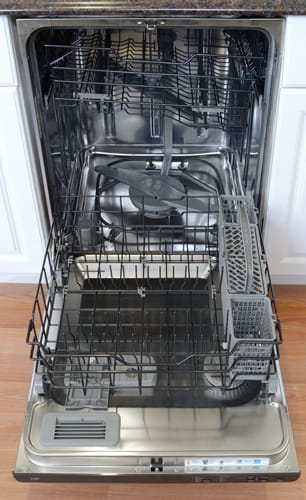
The CDWT980VSS with door open.
Top Rack
{{section_header}}{{section.name}}{{/section_header}}
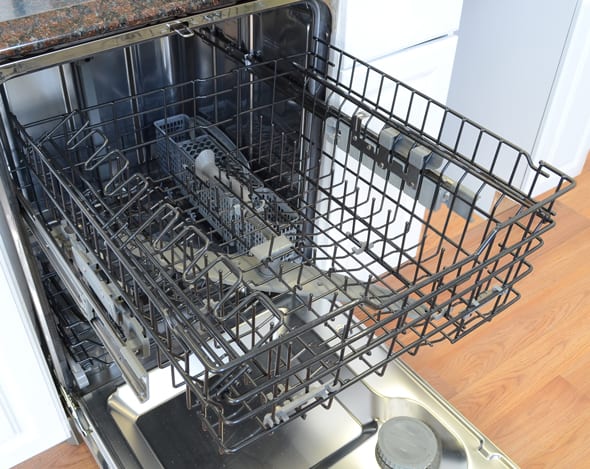
The top rack of the CDWT980VSS.
Bottom Rack
{{section_header}}{{section.name}}{{/section_header}}
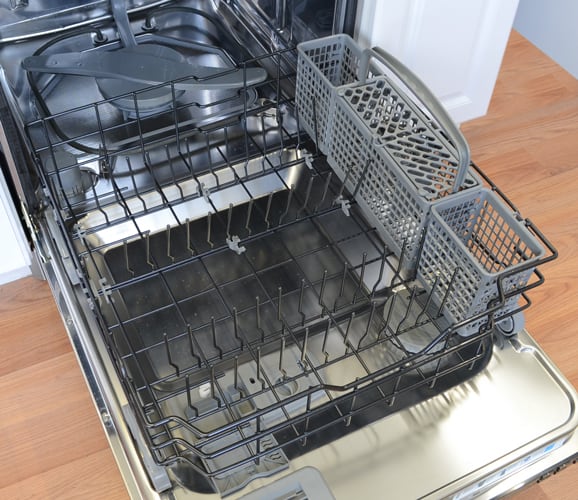
The bottom rack of the CDWT980VSS.
Cutlery Basket
{{section_header}}{{section.name}}{{/section_header}}
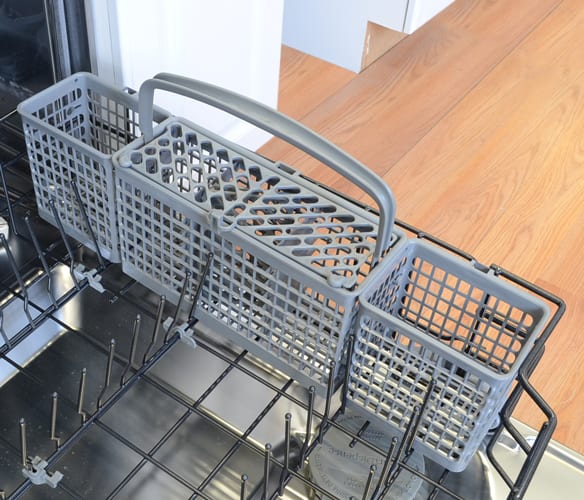
The CDWT980VSS cutlery basket.
Electricity Use
{{section_header}}{{section.name}}{{/section_header}}
Bosch's design places the zeolite—about 1.2 kilograms of it—in a compartment under the main washing cavity. Once all the dishes have been cleaned, steam is siphoned off out of the dishwasher and into the zeolite compartment. At this point, the mineral undergoes a natural reaction by which it heats up to over 100 degrees Celsius, or 212 degrees Fahrenheit. This heat is then sucked into the dishwasher, where it causes any remaining moisture to evaporate, leaving dishes sparkling and quite dry.
To dry out the zeolite again, simply run another cycle. The energy used to heat the water for the initial washing portion also heats the zeolite, causing it to dry out. It's literary a cycle of rinse and repeat, where you don't have to do anything more than push the start button. It's perpetually self-renewing: like yeast, the zeolite never stops or breaks or wears out, regardless of how often you use the dishwasher or how infrequently. The short version is, instead of having the dishwasher heat up twice—once to wash and once to dry—it only has to do it the one time. It's a huge long-term energy reduction that will theoretically save you enough money to make the €1200 price worth it.

Water Use
{{section_header}}{{section.name}}{{/section_header}}
These models are designed to shoot for the highest energy efficiency rating in Europe. As far as water conservation is concerned, a technical representative explained that the Bosch machine will use as little as six liters of water for every load, with a standard consumption rate of seven liters. Additionally, the pre-wash portion of the cycle uses what is known as grey water, or water that has already been used. A storage tank on the right side of the dishwasher holds about 1.8 liters which fills using the water used previously in the cycle's final rinse. It's stored for the pre-wash portion of the next cycle, which doesn't necessarily require fresh or perfectly clean water. Having to use almost two liters less per load will have a definite impact on your water bill, though we did have a concern pertaining to consumers that like to cook smelly foods. You may want to hand wash any dishes used on fish night, for instance, just in case...

Yearly Running Cost
{{section_header}}{{section.name}}{{/section_header}}
Annual running costs are impossible to calculate off of a show floor model, but company representatives said this machine is designed to dramatically cut down on energy fees. The catch is, the few models equipped with Zeolite technology are priced relatively high: average value as calculated for the American market would be at least about $1512 for a new model. The idea, though, is that the massive energy reduction between what you'll save in electricity and what you'll save in water consumption will pay you back in the long run. Given that these dishwashers supposedly have a life expectancy of anywhere from 10 to 15 years, that's quite a lot cut out of your annual utility bill, especially if you live in a large household that uses a lot of dishes on a regular basis.
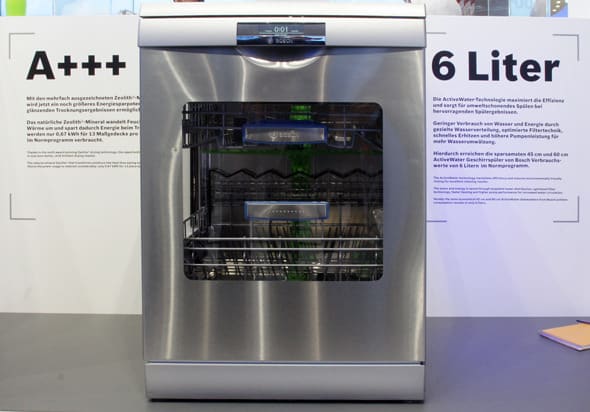
{{comparison_bars title="Yearly Running Cost", attribute="Yearly Running Cost", xLabel="Cost to run over a typical year ($)"}}
Conclusion
{{product.vanity}}
With their Zeolite dishwashers, Bosch is targeting a particular consumer market that is focused primarily on long-term energy savings over initial cost. At least, we can only assume that's what Bosch is doing, since they're pricing what they say is their most energy efficient dishwasher at €1200, or about $1512. That kind of blow to the wallet puts these machines at a clearly higher bracket than nearly every other model we test, but it's that pricey for a reason. These machines include their patented Zeolite drying technology, which they've had around for about two years now. This natural mineral produces intense levels of heat when exposed to regular water, dramatically reducing the amount of energy needed to heat the inside of the dishwasher during a cycle. Representatives claimed that you could count on these dishwashers to last anywhere from 10 to 15 years, so purchasing one of these products theoretically guarantees you about a decade and a half of dramatically cut utility bills.
To date, there are only three models with zeolite installed, and they happen to be available in Europe, Australia, and the United...oh, wait...sorry, that third location is actually India. Americans will just have to keep washing their dishes the old fashioned way for now, using lots of electricity and water to get the job done. Assuming Bosch's machines last as long as they estimate and hold up to long-term testing, they'll definitely make for solid investments. The technology and ensuing results seem like great incentives, so hopefully we'll be able to see them in our part of the world some time soon.
Meet the tester
Matthew is a native of Brockton, MA and a graduate of Northeastern, where he earned a degree in English and Theatre. He has also studied at the Gaiety School of Acting in Dublin and spends most of his free time pursuing a performance career in the greater Boston area.
Checking our work.
Our team is here for one purpose: to help you buy the best stuff and love what you own. Our writers, editors, and lab technicians obsess over the products we cover to make sure you're confident and satisfied. Have a different opinion about something we recommend? Email us and we'll compare notes.
Shoot us an email
